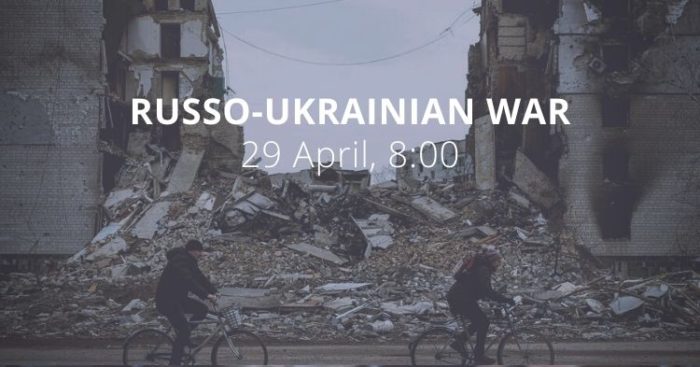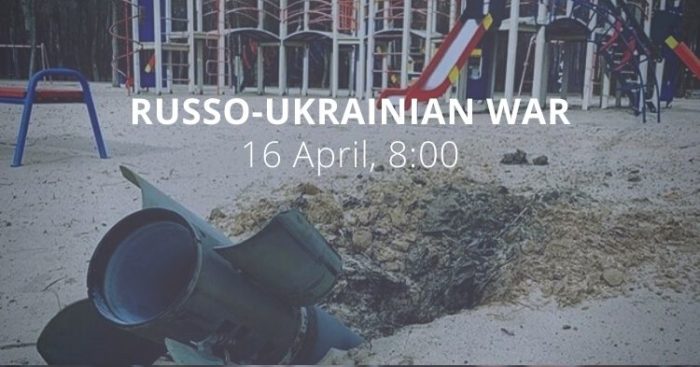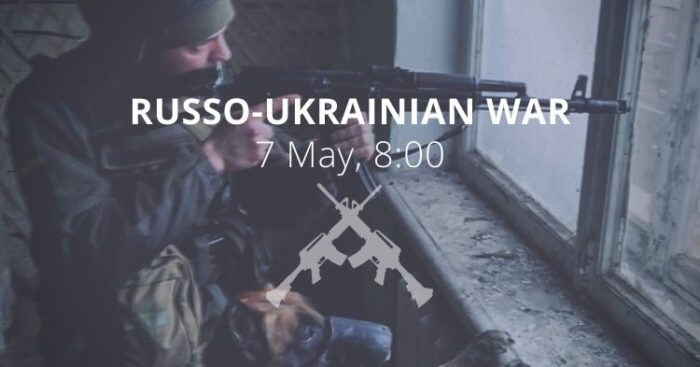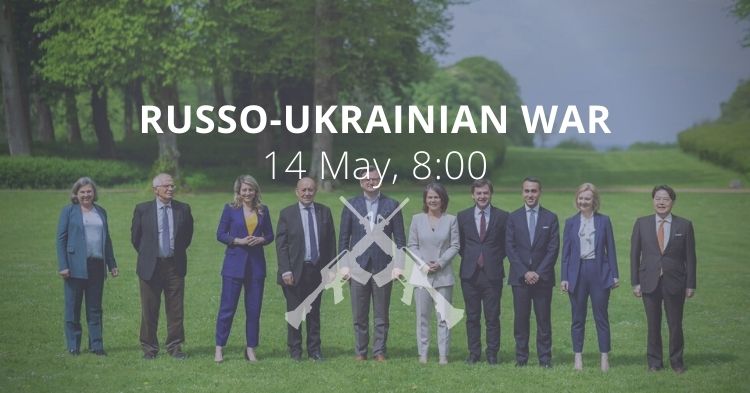Morning report day 65 – April 29
Situation
According to information from the General Staff:
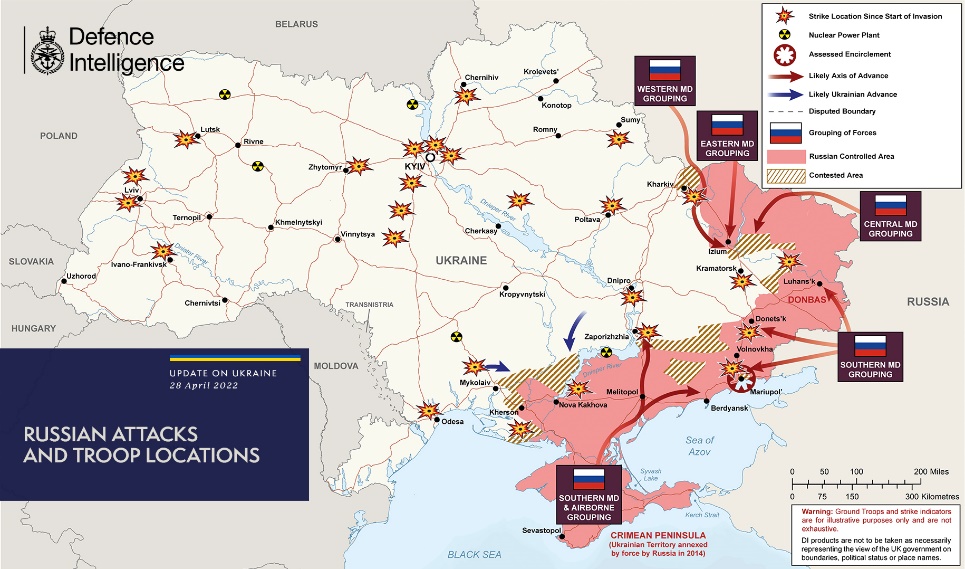 In the Volyn and Polissya areas, Russian forces did not take active action, and no signs of the formation of offensive groups were found. Certain units of the Armed Forces of the Republic of Belarus continue to perform tasks to strengthen the protection of the state border with Ukraine.
In the Volyn and Polissya areas, Russian forces did not take active action, and no signs of the formation of offensive groups were found. Certain units of the Armed Forces of the Republic of Belarus continue to perform tasks to strengthen the protection of the state border with Ukraine.
- No significant changes in Russian forces' activity have been recorded in the Volyn and Polissya areas. Russian forces aircraft continue to launch missiles and airstrikes on targets in Ukraine from the territory of the Republic of Belarus. According to available information, the aviation units of the Air Force of the Russian federation continue to use the Baranovichi airfield. The air defense means of the Armed Forces of the Republic of Belarus continue to be on duty in an enhanced mode.
No changes in the activities and composition of the Russian forces were detected in the Seversky direction.
- In the Sicersky direction, there are no signs of forces formation of the group to resume the offensive. Russian occupiers are taking measures to strengthen the coverage of certain areas of the border. Thus, additional units of the rosguard were deployed to the border zone in the direction of Chernihiv and Sumy oblasts.
In the Slobozhansky direction, Russian forces continue to focus their efforts on maintaining their positions near the city of Kharkiv and are trying to carry out fire damage to units of the Armed Forces of Ukraine in certain areas.
- Russian forces did not conduct active offensive operations in the Izium direction. its main efforts were focused on conducting reconnaissance, identifying the defensive positions of units of the Defense Forces of Ukraine and their destruction by artillery fire.
- In the Slobozhansky direction, Russian forces deployed up to five divisions of the Iskander-M (SS-26 Stone) mobile short-range ballistic missile system in the Belgorod Oblast. Russian forces continue to regroup their forces. According to available information, Russian forces brought a battalion tactical group of airborne troops to the territory of the Russian Federation to restore combat capability due to significant losses in personnel and military equipment. In addition, a battalion tactical group from the 29th Combined Arms Army of the Eastern Military District was moved from the territory of the Belgorod Oblast of the Russian Federation to the Kharkiv Oblast. The forces continue air reconnaissance with unmanned aerial vehicles.
- Russian forces units attempted to attack the positions of the Defense Forces of Ukraine in the directions of Brazhkivka and Dovhenke. They were unsuccessful, lost and withdrew. Russian occupiers also tried unsuccessfully to take control of the main objects of the Velyka Komyshuvakha.
- The Defense Forces of Ukraine have restored control over the settlement of Kutuzivka in the Kharkiv Oblast.
In the Donetsk and Tavriya directions, in order to prevent the regrouping of Ukrainian troops, Russian forces fire at positions from artillery, mortars, and rocket-propelled grenade launchers along the entire line of contact.
- Russian occupiers continue to blockade Ukrainian units in Mariupol, near the Azovstal plant.
- In the Donetsk and Tavriya directions, in order to bind our troops and hold the previously occupied frontiers, Russian forces fired on the positions of Ukrainian defense units using multiple rocket launcher systems and artillery almost along the entire line of contact.
- Russian forces tried to completely capture Rubizhne, but were unsuccessful, suffered losses and retreated to previously occupied positions.
- In the Kurakhiv direction, Russian forces unsuccessfully tried to advance in the directions of the settlements of Solodke and Novomykhailivka.
- Russian forces continued to launch airstrikes on Mariupol. The main efforts were focused on blocking our units in the area of the Azovstal plant in order to prevent their breakthrough.
- In the direction of Donetsk - Zaporizhzhia, the forces launched an offensive in the direction of the settlements Neskuchne and Vremivka, and had no success. It continues to strengthen the grouping of troops.https://twitter.com/EuromaidanPress/status/1519836550661656579?s=20&t=c1xA7qQ8GQ6YhmjkcGcdDA
In the Pivdenny Buh direction, attempts to storm the forces in the areas of the settlements of Oleksandrivka, Tavriyske, Ivanivka, and Zahradivka were successfully repulsed.
The Black Sea Fleet in the Black and Azov Seas continue to launch missile strikes on the territory of Ukraine, perform tasks to isolate the area of hostilities and conduct reconnaissance.
Fifteen air targets were hit by Ukrainian defenders the day before: one plane, five cruise missiles and nine operational-tactical drones.
Ukrainian defenders are actively maneuvering defense, in some places counterattacks. In the Donetsk and Luhansk oblasts alone, nine Russian attacks have been repulsed in the past 24 hours and six tanks, one artillery system, twelve armored vehicles, one car, and one anti-aircraft gun have been destroyed.”
Ukraine will be defended by strikes on warehouses and bases of the Russian Federation, the world recognizes our right – Podoliak, the Ukrainska Pravda reports. "Ukraine must decide for itself whether to strike at Russian military facilities, Blinken said. Russia has attacked Ukraine and killed civilians. Ukraine will defend itself in any way, including by attacking warehouses and bases of Russian assassins. The world recognizes this right", Adviser to the Head of the President's Office Mykhailo Podoliak said on Twitter. Ukraine has neither denied nor claimed responsibility for the recent explosions and fires at strategic sites. Significant Ukrainian attacks into Russian territory would mark a major escalation in the war.
"Russia is trying to learn from mistakes it made early in Ukraine. They are attempting to fix the communications and coordination failures observed in the attack on Kyiv. Its progress is slow and uneven now," a senior US defense official said. https://t.co/bokJBh62KN
— Euromaidan Press (@EuromaidanPress) April 29, 2022
"To ensure employment" - in the "Transnistrian region" announced military training, the Defense Intelligence of Ukraine (DIU) claims. "The unrecognized "Transnistrian Moldavian Republic" strengthens its army. The letter of the Ministry of Defense of Transnistria to the heads of local administrations reveals information on the drafting of citizens to the "special training". It is noted that the purpose of the meeting is to "ensure 100% staffing of the Peacekeeping Contingent of the Transnistrian Moldavian Republic
, as well as to provide employment for the working population of the republic."
“Men under the age of 55, who are guaranteed "financial and material security, accommodation and food", can take part in the training. Financial support for unemployed citizens is promised from 2,800 "rubles of Transnistria". The meeting itself will last 90 days.
Despite the formal voluntary participation in the training, there is information that the draft will be coercive.
It is noteworthy that the letter is dated April 21. That is, before the beginning of the last Russian provocations on the territory of "PMR". This is reminiscent of the events in the so-called "LNR / DNR" on the eve of a full-scale Russian invasion of Ukraine.”
Ukrainian defense forces strengthen protection of border with Moldova, the Ukrinform reports. Given a series of Russian provocations in the self-declared breakaway republic of Transnistria, the defense forces of the Odesa Oblast have strengthened the protection of the state border with Moldova. Serhii Bratchuk, the spokesman for the Odesa Oblast military administration, said this on Telegram, Ukrinform reports.
According to British Defense Intelligence, (last 24 hours):
- The Battle of Donbas remains Russia’s main strategic focus, in order to achieve its stated aim of securing control over the Donetsk and Luhansk oblasts.
- In these oblasts fighting has been particularly heavy around Lysychansk and Sievierodonetsk, with an attempted advance south from Izium towards Sloviansk.
- Due to strong Ukrainian resistance, Russian territorial gains have been limited and achieved at a significant cost to Russian forces.
As of Friday 29.04.2022, the approximate losses of weapons and military equipment of the Russian Armed Forces from the beginning of the war to the present day: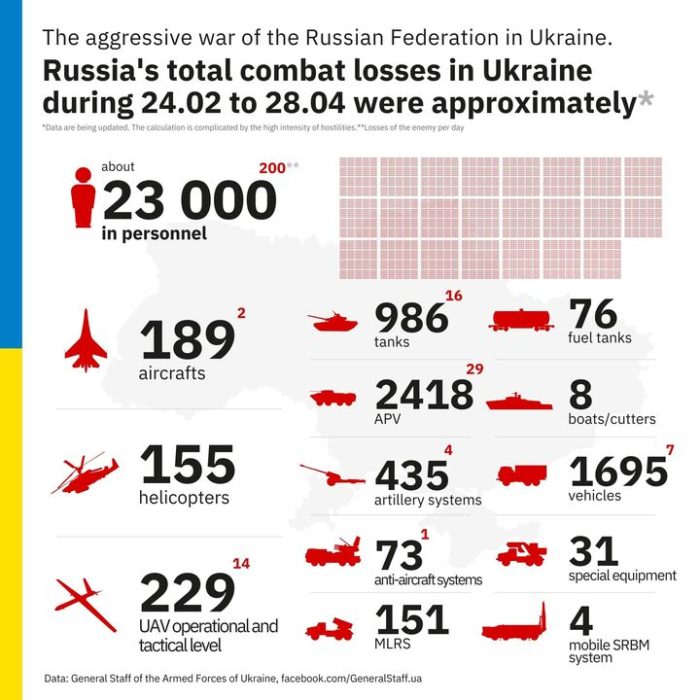
- Personnel – more than 23000 people (+200),
- Tanks – 986 units (+16),
- Armored combat vehicles – 2418 units (+29),
- Artillery systems – 435 (+4),
- Multiple rocket launchers – 151 (+0)
- Air defense means – 73 (+1),
- Aircraft - 189 (+2),
- Helicopters - 155 (+0),
- Automotive technology – 1695 (+7),
- Vessels/boats - 8 units (+0),
- Fuel and lubricant tanks – 76 (+0),
- UAV operational and tactical level – 229 (+14)
- Special equipment – 31 (+0)
- Mobile SRBM system – 4 (+0)
Humanitarian
25 million people may need humanitarian aid by the end of the year, the European Truth reports. "As of now, 3.4 million citizens in Ukraine have been provided with humanitarian aid, and we are ready and intend to reach 8.7 million people by the end of August," he said. "Under the worst-case scenario, 25 million people may need humanitarian aid by the end of the year. I hope this scenario will remain on paper, but we are ready," UN Secretary-General Antonio Guterres said at a press conference in Kyiv.
"Rescuers who are continuing to inspect and dismantle the debris of a residential building in the Shevchenkivskyi district, where a rocket hit yesterday, found a body of a person killed by the Russian rocket, " Kyiv Mayor Vitali Klitschko reports. https://t.co/h7ujW3qgKn
— Euromaidan Press (@EuromaidanPress) April 29, 2022
According to UNHCR 5,372,854 refugees have been registered as of April 27. The UN says that so far Poland has taken in 2,968,716 refugees, Romania 801,453, Russian Federation 641,752, Hungary 507,849, Republic of Moldova 439,290, Slovakia 363,940, and Belarus 24,857. Among those who fled Ukraine are also Ukrainian nationals with dual citizenship. An additional 105,000 people moved to the Russian Federation from the Donetsk and Luhansk oblasts between 18 and 23 February.
The number of Ukrainians entering Ukraine since February 28 is 1,233,500 as of April 27. This figure reflects cross-border movements, which can be pendular, and does not necessarily indicate sustainable returns.
OHCHR recorded 6,009 civilian casualties in Ukraine as of April 27. 2,829 were killed (including 205 children) and 3,180 injured (including 303 children).
The UN Coordinator leaves for Zaporizhzhia to make preparations for possible evacuation from Mariupol, the Ukrinform reports. At the request of UN Secretary-General António Guterres, UN Resident and Humanitarian Coordinator in Ukraine Osnat Lubrani has left for Zaporizhzhia to prepare for a hopeful evacuation from the besieged city of Mariupol. The relevant statement was made by UN Resident and Humanitarian Coordinator in Ukraine Osnat Lubrani on Twitter, an Ukrinform correspondent reports.
https://twitter.com/EuromaidanPress/status/1519961806260822016?s=20&t=c1xA7qQ8GQ6YhmjkcGcdDA
25% of Ukrainians have already returned home – Forbes, the Economic Truth reports. The share of Ukrainian migrants and internally displaced persons who returned home during the war is 25%. This was reported by Forbes, citing data from the UN, Ukrainian and foreign governments, as well as an analysis of the movement of Ukrainians from Vodafone Ukraine. The data are estimated and do not claim absolute accuracy.
"About 9 million Ukrainians remain far from their own homes - more than 20% of the total population. Including 5 million are within the state, 4 million - abroad, most - in Poland," - said in a statement.
Of the 2.9 million refugees who have crossed the Ukrainian-Polish border since the start of the war, more than 1 million have entered Poland to travel to other countries, and more than 700,000 have returned to Ukraine.
Environmental
UN atomic agency investigating report missile flew over Ukrainian nuclear plant, the Washington Post reports.
“Ukraine’s nuclear regulator recorded a missile flying directly over the South Ukraine Nuclear Power Plant on April 16, the International Atomic Energy Agency (IAEA) said in a Thursday news release. Director general Rafael Mariano Grossi said the IAEA was looking into the report, which would be “extremely serious” if confirmed. Had such a missile gone astray, it could have had a severe impact on the physical integrity of the nuclear power plant potentially leading to a nuclear accident, he said in the news release.”
MFA Ukraine on invaders expropriating Ukrainian grain: Russia walks in the footsteps of Stalinists, Nazis, the Ukrinform reports. The Ministry of Foreign Affairs of Ukraine strongly condemns Russia's criminal actions related to the so-called "expropriation" of farmers’ crops in the temporarily occupied parts of the Kherson Oblast. This is stated in a comment by the Foreign Ministry, Ukrinform reports.
“The Foreign Ministry stressed that the decision of the Legislative Assembly of Russia’s Krasnoyarsk Territory is nothing but a direct continuation of the criminal policy pursued by the Soviet government responsible for the Holodomor of 1932-1933 and the mass artificial famine of 1921-1923 and 1946-1947. "By stealing grain, which the invaders refer to as 'expropriation,' Russia is following in the footsteps of Stalinists and Nazis," Ukrainian diplomats said.
The Foreign Ministry stressed that looting of grain from the Kherson Oblast, as well as blocking shipments from Ukrainian ports and planting mines on maritime navigation routes threaten the world's food security. The diplomats reminded that Ukraine provides food to almost 400 million people worldwide as Ukrainian grain is traditionally exported to Europe, North Africa, the Middle East, and Asia.
"By its illegal actions, Russia is in fact robbing not only Ukraine but also foreign consumers. The United Nations estimates that about 1.7 billion people may face poverty and famine due to food disruptions as a result of a full-scale war waged by Russia against Ukraine. In addition, Russia continues to deliberately block Ukraine’s sowing campaign, destroying agricultural machinery and launching missile strikes throughout our country," the statement said.
The Foreign Ministry stressed that the criminal export of Ukrainian grain is yet another evidence of Russia's destructive actions, violating the basic principles of the Food and Agriculture Organization of the United Nations (FAO) - ensuring food security and overcoming hunger. "Such a policy of the aggressor state calls into question the expediency of its membership in FAO and other international organizations," the ministry said.
In this regard, Ukraine demands that Russia cease the illegal theft of grain, unblock Ukrainian ports, restore freedom of navigation, and allow the passage of merchant ships. Also, Ukraine calls on the international community to strengthen economic sanctions to stop Russia's armed aggression against Ukraine and to prevent humanitarian catastrophe and deterioration of food security around the world.
As reported, the Legislative Assembly of the Krasnoyarsk Territory of the Russian Federation published on its website its plans to "expropriate the surplus crops of Kherson Oblast’s farmers."
Legal
The occupiers forcibly deported more than 30,000 people from Mariupol to Russia, the Ukrainska Pravda reports citing Chairman of the Donetsk OVA, Pavlo Kyrylenko. They take them to their so-called filtration camps, which are located near Mariupol before being forcibly taken to the territory of the so-called "DNR" or Russia.
“85% of buildings in the Volnovakha district of Donetsk Oblast are destroyed or damaged, 50% - can no longer be restored. Also, according to him, the shelling does not subside in the settlements of Mariinka, Krasnohorivka, and Svitlodarsk. Large cities in the oblast, such as Kramatorsk, Sloviansk and Pokrovsk, are being hit by missiles. According to Kyrylenko, 370,000 people remain in the Ukrainian-controlled part of the Donetsk Oblast, excluding Mariupol residents. As of February 24, this year, 1,670,000 people lived in the Oblast.”
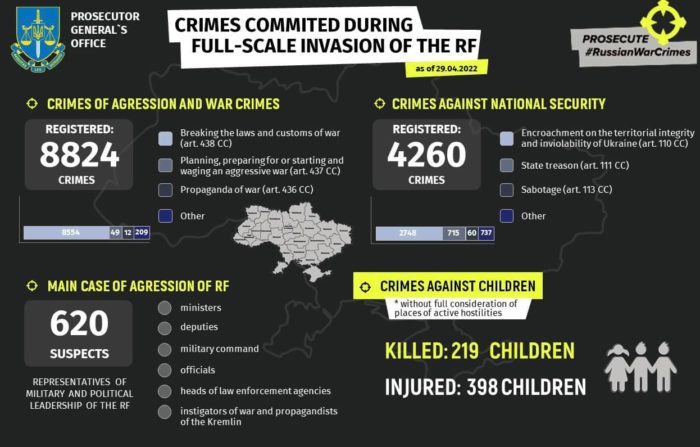 219 children were killed, and 398 children injured, the Office of the Prosecutor General of Ukraine reports as of 28 April. 1,556 educational establishments are damaged as a result of shelling and bombings, 102 of them are destroyed fully. 8,824 crimes of aggression and war crimes and 4,260 crimes against national security were registered.
219 children were killed, and 398 children injured, the Office of the Prosecutor General of Ukraine reports as of 28 April. 1,556 educational establishments are damaged as a result of shelling and bombings, 102 of them are destroyed fully. 8,824 crimes of aggression and war crimes and 4,260 crimes against national security were registered.
According to the General Staff of Ukraine, Russian occupation authorities continue to take measures to restrict the movement and detention of local residents and block humanitarian goods from the territory of Ukraine in the temporarily occupied territories. In addition, Russian occupiers are robbing peasants. For example, more than 60 tons of wheat were stolen from an agricultural society in the town of Kamianka-Dniprovska together with a truck.
Support
US Congress revives World War Two-era "Lend-Lease" program for Ukraine, the Reuters reports. The US House of Representatives overwhelmingly backed legislation on Thursday that will make it easier to export military equipment to Ukraine, reviving the "Lend-Lease Act" that helped defeat Hitler during World War Two. The House passed the "Ukraine Democracy Defense Lend-Lease Act of 2022" by 417 to 10, three weeks after it sailed through the Senate with unanimous support. It next goes to the White House for President Biden to sign into law.
“Two months into the Russian invasion of Ukraine, members of Congress hoped the act would work as it did eight decades ago by allowing US companies to quickly resupply partner nations without having to clear bureaucratic hurdles. Among other provisions, the bill would allow the United States to provide equipment to Ukraine now, with just a technical requirement to pay at a later date, essentially giving it to the Kyiv government.”
Biden asks Congress for $33bn aid military&economic package to Ukraine, more than doubling assistance to date
It would allow to seize Russian oligarchs' assets to be used for the benefit of Ukraine, include more artillery&APCs, more intel sharinghttps://t.co/g2qN6ApO36
— Euromaidan Press (@EuromaidanPress) April 28, 2022
Germany will deliver heavy weapons to Ukraine, the Bild reports. The Bundestag voted Thursday for the delivery of heavy weapons to Ukraine. With a large majority of 586 votes, the deputies called on the federal government to “continue and, where possible, accelerate the delivery of necessary equipment to Ukraine and also expand the delivery to include heavy weapons and complex systems”. Germany's ability to defend the alliance should not be jeopardized. 100 MPs voted no, 7 abstained.
“The federal government also received explicit backing for all the steps taken so far, including sanctions against Russia, help with war crimes investigations and the restructuring of Germany's infrastructure to no longer be dependent on Russian energy supplies. "The German Bundestag condemns in the strongest possible terms Russia's brutal war of aggression against Ukraine. In doing so, Russia is blatantly breaking international and humanitarian law and is attempting to permanently destroy the European peace order.”
Ukrainian Air Force asks for modern air defense systems and fighter jets, the Ukrinform reports. The Ukrainian Air Force Command reported this on Telegram, according to Ukrinform. "The weapons that were given to us are not enough to win!
“For the Air Force to cover the skies over Ukraine, the Stinger and Starstreak MANPADS alone that was provided by our partners are not enough. These are portable short-range systems primarily designed to destroy low-altitude targets, such as helicopters," said Lieutenant General Mykola Oleshchuk, the commander of the Ukrainian Air Force.
According to him, now Ukraine needs modern medium and long-range anti-aircraft missile systems and modern fighter jets for the effective protection of Ukrainian airspace. "We would very much like to receive (on any terms) Western-made equipment that is technological and effective. The war will not end soon, we need weapons today," Oleschuk added.
Biden asks Congress for a new $33 billion Ukraine aid package, the Defense News reports. President Biden on Thursday asked Congress to pass a proposed $33 billion Ukraine aid package, including more than $20 billion in military aid and other security assistance. The supplemental funding request includes $16.4 billion for the Defense Department, $8.5 billion in economic assistance, and $3 billion for humanitarian assistance and to fight food insecurity.
“Additional security assistance will put urgently needed equipment into the hands of Ukraine’s military and police, including ammunition, armored vehicles, small arms, demining assistance and unmanned aircraft systems,” Biden wrote in a letter to House Speaker Nancy Pelosi.
The UN is preparing a unique operation to pay cash to 2 million Ukrainians, the European Truth reports. "We are ready to provide cash payments - 1.3 million by the end of May, 2 million by August, but this will be in coordination with the Ukrainian government," Guterres said. This was stated by UN Secretary-General Antonio Guterres at a press conference in Kyiv. Cash payments to victims are a standard UN tool, but in Ukraine, it has a special feature, as the organization usually distributes money where the government is unable to do so. "This is an atypical humanitarian operation for the UN because Ukraine has a functioning government, a system of government. Therefore, our task is not to replace but to support the government," he explained. In addition, Guterres said, other support will be provided.
After all the atrocities of the Russian army, 74% of Russians support the war with Ukraine, Ukrainska Pravda reports citing the renowned Russian Levada Centre. According to the poll, as of the end of April, after 2 months of the war with Ukraine, 74% of Russians support Russia's attack on Ukraine and the actions of Russian occupation forces. 19% do not support the actions of the Russian Federation. Support for the actions of the Russian Armed Forces in Ukraine remains high, but compared to March, it has slightly decreased (7%). The majority of respondents blame the destruction and death of civilians in Ukraine on NATO countries. 39% said that they do not monitor the war in Ukraine. Most Russians answered that they were "worried" about the war in Ukraine (82%). At the same time, only 6% of Russians said they were afraid of the "Nazis" and only 5% were worried that the war could spread to Russia. 68% of Russians believe that the war with Ukraine is going well. 27% thought everything is going "according to plan".
New developments
- NATO accession process if Finland and Sweden decide to apply - NATO Secretary-General. “If they decide to apply, Finland and Sweden will be welcomed with open arms to NATO. Finland and Sweden are our closest partners, they are strong, mature democracies, EU members, and we have worked with Finland and Sweden for many, many years. We know that their armed forces meet NATO standards, are interoperable with NATO forces, we train together, we exercise together, and we have also worked with Finland and Sweden in many different missions and operations. So if they apply, they will be welcomed, and I also expect the process to be quick”. US will 'strongly support’ NATO bids of Sweden and Finland, the Washington Post reports.
- Russia warns West: Don't test our patience, the Reuters reports.” Russia on Thursday warned the West that there would be a tough military response to any further attack on Russian territory, accusing the United States and its key allies of undermining European security by openly inciting Ukraine to assault Russia” after Russia started its war against Ukraine in 2014.
- USA, Germany, Israel and other countries call on their citizens to leave Transnistria immediately, the TSN reports. Several countries are concerned about the situation in Transnistria and are, therefore, asking their citizens to leave the territory. The Foreign Ministries of Israel, Germany, Canada, the USA, France, Great Britain and Bulgaria have addressed their citizens according to the news outlet.
- Zelenskyy calls on the UN to make efforts to stop the deportation of Ukrainians to Russia, the Ukrinform reports. He said this at a briefing following a meeting with UN Secretary-General Antonio Guterres in Kyiv on Thursday, Ukrinform reports. "I called on the Secretary-General to make efforts to stop the deportation of Ukrainian citizens to Russia. Russia is illegally and forcibly relocating adults and children. Hundreds of thousands of Ukrainians have already been abducted. The Office of the United Nations High Commissioner for Refugees and the International Organization for Migration are very important tools and the tasks for them now, in our opinion, are to gain access to our citizens who were deported to the Russian Federation and ensure their return home, to Ukraine, as soon as possible," Zelenskyy said.
- Germany is ready to stop buying Russian oil, paving the way for a European Union ban on crude oil imports from Russia, the Economic Truth reports citing The Wall Street Journal. “Berlin has been one of the main opponents of EU sanctions on oil and gas trade with Moscow. However, on Wednesday, Germany's representatives at EU institutions withdrew the country's objections to a full embargo on Russian oil, provided that Berlin was given enough time to secure alternative supplies, two officials said. A change in Germany's position increases the likelihood that EU countries will agree on a phased embargo on Russian oil, with a solution possible next week, diplomats and officials say.”
Germany is now ready to stop buying Russian oil, clearing the way for a European Union ban on crude imports from Russia, government officials said. - WSJ
Berlin had been one of the main opponents of sanctioning EU’s oil-and-gas trade w/ Moscow
https://t.co/6VXtSewUNq.— Euromaidan Press (@EuromaidanPress) April 29, 2022
Assessment
On the War
The Institute for the Study of War has made the following assessment as of Thursday 28 April:
Ukrainian news outlet Defense Express reported on April 27 that Russian Chief of the General Staff Valery Gerasimov will take personal command of the Russian offensive in the Izium direction. Citing unspecified Ukrainian military sources, Defense Express stated that Gerasimov is already in-theater and will command the offensive “at the operational and tactical level” and claimed the Russian military failed to create a single command structure under Southern Military District Commander Alexander Dvornikov
. ISW cannot independently confirm this report. However, ISW previously assessed that Dvornikov’s appointment as overall commander in Ukraine would not solve Russia’s command and control challenges and likely strain his span of control. If confirmed, the appointment of Russia’s senior general officer to command tactical operations indicates both the importance of the Izium drive to Russia’s war in Ukraine and the breakdown in the Russian military’s normal chain of command.
Key Takeaways
- Russian strategic bombers likely targeted a Ukrainian field hospital in the Azovstal Steel Plant. The remaining Ukrainian defenders are likely running low on supplies.
- Russian attacks southwest of Izium likely seek to outflank Ukrainian defenses on the direct road to Sloviansk and have made tactical gains in the last 24 hours.
- Russian forces continued tactical ground attacks and shelling along the entire line of contact in eastern Ukraine but did not secure any major advances.
- Donetsk People’s Republic (DNR) Head Denis Pushilin stated that the DNR will postpone local Victory Day celebrations planned for May 9 until “the complete victory and the expansion of the DNR" to control Donetsk Oblast, though the Kremlin remains likely to attempt to claim some sort of victory on May 9.
- Russian forces conducted several locally successful attacks from Kherson toward Mykolaiv.
- Russian and proxy forces continued to mobilize in Transnistria and set conditions for a false flag attack.“
The Kremlin is considering "establishing a new state" under the name "Southern Russia" on the Ukrainian occupied territories according to an intercepted document available to the Schemes, Radio Svaboda reports.
The document further emphasizes that the so-called "Southern Russia" is the "successor" of Kievan Novgorod Russia, the Zaporozhian Sich, the so-called "New Russia of the time of Catherine the Great" and the USSR. "We are building our state based on understanding the historical and genetic kinship and unity of the Russian people, Ukrainians, Belarusians and Russians, fraternal friendship and mutual assistance," the authors of the manifesto emphasize. Orthodoxy is called the "foundation of our culture and identity", while the Ukrainian language is called a "dialect". "We recognize the Russian language, as well as the Ukrainian dialect, as the native and language of interethnic communication, with equality of all languages and nationalities," the text reads. The main goal of "Southern Russia" the authors call "the achievement and protection of peace", "complete eradication of Nazism and Bandera." And they are announcing a "nationwide referendum". "We recognize the freedom and the right to express the will of the people of Crimea, we recognize the choice of Donbas. The state of Southern Russia will also exist and act after the transition period based on universal, open to observers of all countries, the will of the people through a referendum, " - said in the text of the" manifesto ". At the same time, the document does not specify in which territories of Ukraine it is planned to "form" "Southern Russia".
The metadata of the document helped identify the probable author, the date of its creation (April 16) and the ownership of the computer used (United Russia). The probable author, Roman Mykolayovych Romanov is the Deputy Chairman of the United Russia Central Executive Committee.
According to "Schemes", the "manifesto" has passed from hand to hand. First, it was received by Andrei Turchak, First Deputy Chairman of the Federation of the Federal Assembly of the Russian Federation and the secretary of the General Council of the United Russia party. Subsequently, according to journalists, Turchak passed this "manifesto" to another "United Russia" Dmitry Gryzlov , an aide to the sanctioned Russian businessman Konstantin Malofeev - who is known as the "sponsor of the war in Donbas." He is believed to have financed separatists in the Crimea and Donbas, and Malofeev's former subordinate Igor Strelkov (Girkin) became the most famous field commander of the DNR.
According to a case opened by the Main Directorate of the Main Investigation Department of the Ministry of Internal Affairs of Ukraine, the Russian Ministry of Defense, headed by Shoigu, formed illegal armed groups that seized power, attacked units of the Armed Forces and the National Guard, resulting in numerous casualties. According to the investigation, Malofeev contributed financially and organizationally to this. …
Earlier attempts to organize a pseudo-referendum in the Kherson oblast have become known. Gennady Laguta, the head of the Kherson Oblast Military Administration, told Radio Svoboda about its preparation.
Consequences and what to do?
“Russian aggression may have a new target”, the Editorial Board of the Washington Post writes. Even casual observers of Russia’s aggressive moves leading up to its invasion of Ukraine cannot fail to recognize the eerie — and alarming — parallels with what has been happening over the past few days in Moldova.
It’s far from clear that Russia actually has the military capability to make good on such a threat, though an attempt certainly can’t be ruled out. Two Russian objectives are likely, though: first, to justify wider attacks on Ukraine’s so-far mostly unscathed western region, including Odesa, a port city near Moldova; and, second, to pressurize and destabilize Moldova, which — like Ukraine before it — has signaled its desire to escape Moscow’s orbit definitively in favor of a more Western orientation. In July 2021, a pro-Western party swept into office, backed by 52 percent of Moldovan voters, on a promise to pursue European Union membership and a strategic partnership with the United States. Russia has no legitimate reason to fear any of this, of course. NATO membership, … couldn’t happen for Moldova in part because Moscow’s troops are still on Moldovan territory. Moldova has dealt gingerly with Moscow, which also controls its energy supply, since the war in Ukraine began, declining to join sanctions or to permit weapons to transit its territory. What the government of President Maia Sandu admirably has done is take in some 100,000 Ukrainians, making this nation of 4 million the world’s largest haven for the war’s refugees on a per capita basis. For that reason alone, Ms. Sandu’s government deserves American and European gratitude, sympathy and support. Evidently, Moldova also faces an imperial Russian challenge that is highly reminiscent of the one that faces Ukraine, as the fearful flow of thousands of people out of Transnistria this week vividly illustrates. Western policy failed to respond strongly enough, soon enough, to deter Moscow’s machinations against Ukraine after it took Crimea and Donbas in 2014. Hence the disaster now unfolding across Europe and, indeed, the world. There would be no excuse for making the same mistake twice.”
Assessment by Hans Petter Midttun:
The "Manifesto of the South Russian People's Council" comes across as credible because it reflects past strategies. It fits nicely into the Russian “Novorossiya” ambitions from 2014 to 2015. It’s a copy and paste version of the illegal occupation and annexation of the Crimean Peninsula. The attempt to portray this (contrary to the will of the people) as a legitimate decision is in line with both the Russian disinformation narratives as well as its past modus operandi. The fact that the West never managed to come up with a strategy to help Ukraine unblock the occupied territories, lends credit to the paper.
Crimea was seen as a “lost cause” by the international community from the very beginning of the Russian occupation. The subsequent consequences for the maritime domain were never properly addressed. Additionally, the West insisted that there were “no alternative to the Minsk Agreement” – a peace agreement that by default could never work because it did not encompass the whole conflict – and insisted that there could only be a political solution to the conflict.
The present strategy is not necessarily fundamentally different.
Admittingly, the war has seen the West come together in a manner not seen since the Cold War. The Russian Federation has found itself to be the most sanctioned country in history. NATO Allies have pledged and provided at least US $8 billion in military support to Ukraine. The US has revived a World War Two-era "Lend-Lease" program for Ukraine to ensure both faster and even more comprehensive support. The EU and the world have risen to the challenge posed by the biggest refugee crises in Europe since WW2.
The USA, NATO, and the EU have been propelled into action to meet the new (8-year-old) security situation and are developing new strategies to ensure Russia is contained, isolated and weakened. Defense budgets are being strengthened. Europe has been forced to finally address its long-time energy security problems. Food security challenges are being addressed as our relationship with the Russian Federation is being fundamentally changed. Even the most adherent Russian business partners have been forced to reconsider their relationship.
But all of this happens as a consequence of the realization that European security is at risk. Ukrainian security has after all been at risk for more than 8 years already.
While there is a growing consensus that the West needs to help Ukraine defeat Russia, the defeat itself is not defined. A “Russian defeat” might be related to its initial aim of the invasion; failing to achieve a regime change and control over all of Ukraine. It might involve denying Russia its present (and short-term) campaign objective of establishing control over all of Luhansk, Donetsk, Zaporizhzhia, and Kherson oblast.
It is not given that a Russian defeat involves the full withdrawal of its forces from Ukrainian territory, including the Crimean Peninsula. Nor does it necessarily include the “demilitarization” of the Sea of Azov and the Black Sea.
To achieve this, Ukraine needs different kinds of weapons and support than it is presently receiving. It needs maritime and air surveillance systems, strike capacity (combat aircraft, helicopters, long-range precision missiles, and artillery), and not least, a Navy. Considering the education and training needed to operate the systems effectively, it also needs the operators to be able to force Russia to withdraw in the next couple of months. The longer it takes, the harder it will become as Russia digs in, reorganize, and implement lessons learned.
The West needs to define what the Russian defeat in Ukraine looks like and adapt its strategy accordingly. Presently, evicting Russia from Ukraine does not seem to be an objective in the present USA and NATO strategy.
Until it does, the previous mantra of there being no alternative to a “political resolution of the war” will be looming in the shadows. From experience, we know this will only lead to more conflict and less security for Ukraine.
European security is inherently linked to an independent, sovereign, and secure Ukraine.

